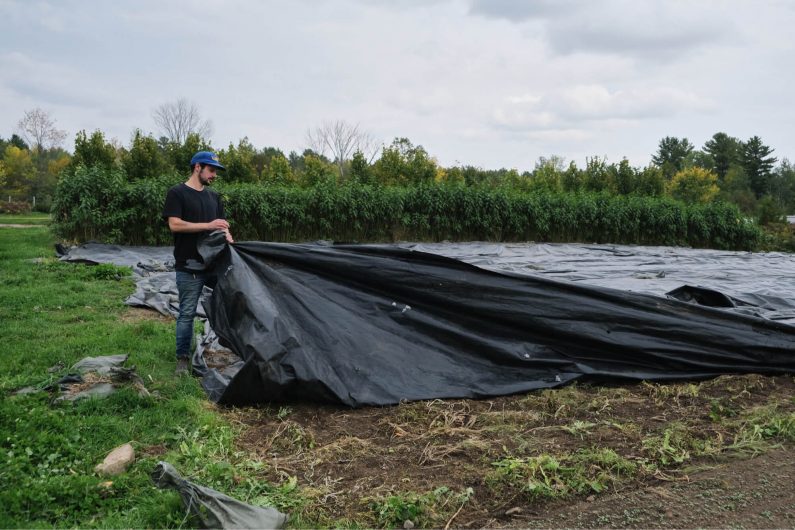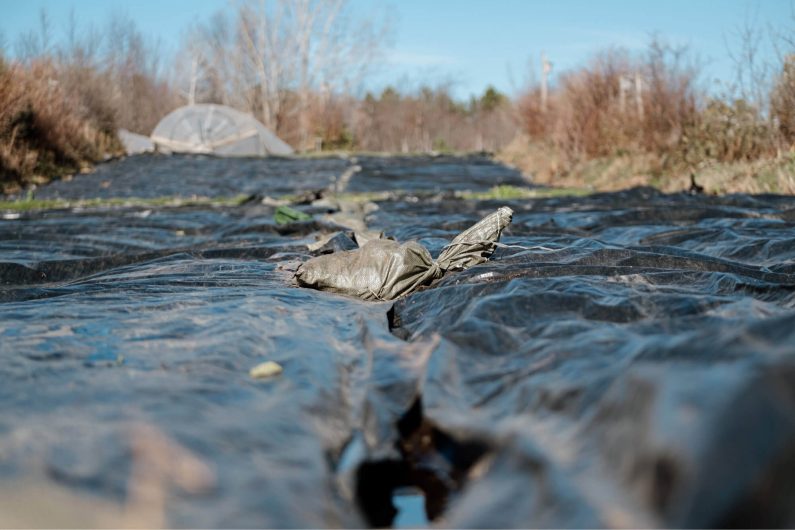This post contains affiliate links. This means if you click and buy, we might make a commission at no cost to you.
Tarps, also known in agriculture as “silage tarps”, are one of the most underestimated tools for small organic farms. They may not seem like much, but as we have experienced, using tarps can really lead to dramatic gains in efficiency while improving soil health. Their immediate and rapid action aligns perfectly with the intensive nature of small-scale farming. You definitively need them on your farm!
When considering how to manage weeds, using tarps is a game-changer. Plus, they are a clever way to incorporate green manure without tilling and can accelerate your bed preparation. As you’ll see, it’s a pretty simple tool and the whole process is quite easy to introduce.
What Are Silage Tarps?
Composed of UV-treated Polyethylene plastic, silage tarps can be used to cover the soil to reduce weed pressure and to help prepare the soil before planting. They are black on both sides and can be bought in any store that sells agricultural supplies or equipment. We use them to cover up silage in dairy operations (hence their name: silage tarps).
They are durable and as long as they are well-maintained, they can be reused year after year.
From a cost standpoint, tarps are reasonably priced for the value they bring to your garden. They can also help you save a lot of time! We recommend the silage tarps from Farmers Friend. Otherwise, we buy directly from Dubois Innovation.

Why Use Tarps for Weed Management
One effective way to eliminate weeds is by occultation. The term, derived from the verb “occult”, means to “cut off view” which really sums it up. By cutting off the light from reaching the soil, you deprive weeds of light. Weed seeds germinate under the tarp and then die because they cannot photosynthesize.
To achieve this, we use 6 mil (thousandth of an inch) opaque black tarps that we place on our seedbeds. When left for long periods –i.e. a minimum of two weeks in the summer and a minimum of three weeks for the other seasons– the tarps create warm, humid conditions in which weed seeds germinate. However, due to the absence of light and air movement, the young weeds are killed quickly. By covering the beds with tarps, you can deplete the energy supply of certain invasive weeds. In time, this gets rid of the problem.
If we have beds that aren’t going to be cultivated immediately, we will also use tarps to cover them at different periods during the growing season. For example, if we use a bed to grow early carrots in the spring and then use the same bed in the fall to grow squash, there will be a few weeks during that period where the bed will be unused. To avoid an invasion of weeds, after harvesting the carrots, we will place a large black tarp over the bed. After that, we leave it there until we are ready to plant the squash.
Once you’re ready to lift the tarps, you will quickly see the benefits of how they diminish weed pressure on subsequent crops. If you don’t have enough time in between plantings to incorporate green manure on an existing bed, occultation is definitely a good technique to apply.
Use Tarps to Incorporate Green Manure
Tarps are also a great way to effectively incorporate green manure into your beds while maintaining the quality and biodiversity of your soil. They fit well into a minimum-till cropping system because they allow green manure to be incorporated into the soil without tilling it. Simply pass the flail mower over the green manure (as one would do with crop residues) and then place the tarp over the beds. This practice speeds up the decomposition of the green manure by creating ideal conditions to stimulate the activity of the soil microorganisms. Hence, tarps are essential for a diverse market garden with fast crop successions.

Bring The Season Forward With Tarps
Covering your gardens with tarps in the fall also reduces the time needed to prepare your beds in the following spring. Thanks to the protection of the tarp, there will be less water accumulated in the soil. As soon as temperatures warm up, remove the tarps and you’ll be ready for cultivation and planting much quicker!
Really, the only challenges that we see are that they are not easy to move around. To overcome this, all you need is enough tarps to have 2 per 10 (100’) bed garden. Then you won’t have to carry many at one time. If this works for you, then find some tarps to support your minimal tillage system and watch the benefits unfold!
Need More Info?
For more inspiration on equipment that can support your farming journey, discover our annual review of 30 key small farm equipment.
To discover other ways to use silage tarps, read the article How to Use Silage Tarps or watch this video about greenhouse tomatoes!











